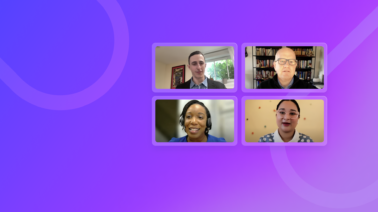 Our goal for Intersect 2017 is to make this conference one of the most valuable experiences of your life and career. We want to support every attendee’s commitment to lifelong learning and the pursuit of rewarding employment to the full measure of our abilities.
Our goal for Intersect 2017 is to make this conference one of the most valuable experiences of your life and career. We want to support every attendee’s commitment to lifelong learning and the pursuit of rewarding employment to the full measure of our abilities.
To that end, we’ve focused very closely on selecting speakers that we know will deliver genuine value and inspiration. We want every guest to be moved, lifted, and motivated by the words and ideas on offer.
This is why we are so excited to have Dr. Steve Abrams as one of our speakers!
If AI is one of the most important technologies of our time (and it is!), and if IBM Watson represents some of the most significant advancements in this field (and it does!), then it’s no stretch to say that Dr. Abrams is one of the most influential voices in this incredible arena.
Dr. Abrams is an IBM Distinguished Engineer and the Vice President of Developer Advocacy at IBM Watson. During his 20 years at IBM, he’s been a leader in areas as diverse as cognitive computing; programming languages, models, and tools; human-computer interaction; and more—all areas that are critical to the evolution of artificial intelligence.
We had the opportunity to talk with Dr. Abrams recently about his career, about IBM Watson, and about Intersect 2017.
Dr. Abrams, on behalf of all at Udacity, we are very excited you will be speaking at Intersect 2017! Can you tell us first about your background? How does your experience align with our curriculum focus on AI, deep learning, machine learning, and self-driving cars?
I first joined IBM in 1992 as an intern in the Manufacturing Research group. Since then, I’ve had the privilege of working with, and eventually leading, technical teams across IBM, playing an active role in technological breakthroughs and witnessing IBM transform industry after industry.
Today, I focus on the progress being made by our growing community of talented developers, companies, and students who are tapping into the Watson platform to build innovative solutions. Our platform is open to everyone, and each day, this group of innovators inspires me. They are creating their own cognitive apps, building new businesses, and transforming entire industries. We see this in the startup community with developer partners like WayBlazer, who developed a cognitive-powered travel platform, with students like Joshua Browder, who created a chatbot called Do Not Pay to help people challenge traffic tickets, and at the enterprise business level with partners like H&R Block.
Not only is IBM giving developers access to cognitive technology, but we’re also dedicated to investing in the education and skills initiatives that will help developers succeed in this new, cognitive economy. Through partnerships with companies like Udacity, we’re able to help developers stay ahead in the workforce and ensure they maintain a competitive edge.
“The conference unites education with the inspiration of modern technology, a pursuit that IBM values and is at the heart of many of our initiatives.”
Being asked to participate in Udacity’s Intersect 2017 is an honor for me—the conference unites education with the inspiration of modern technology, a pursuit that IBM values and is at the heart of many of our initiatives
Cognitive computing is redefining our future, and we encourage our students to start mastering the skills to build with this technology now. Can you speak to how you see these technologies impacting talent sourcing in the coming years, and how you see organizations like Udacity playing a role?
Our chairman has an expression: Change and comfort do not coexist. The way that people engage with technology is changing dramatically. With that comes enormous change in how we work and how we educate ourselves for the future. Today’s professionals must be able to adapt and reorient their skills quickly, and Udacity is at the forefront in this regard—a new model for education and retooling skills.
We’re seeing businesses across industries bring cognitive solutions to market—and these businesses are seeking professionals who understand how to build and deploy AI solutions. According to Evans Data, of the world’s 21 million developers, 8.2 million currently use cognitive computing—there’s no doubt developers must be well versed in AI and cognitive technologies to succeed in the coming years. We are proud to team up with Udacity and play a critical role in educating the next generation of our workforce.
“We’ve always felt that the best way to advance cognitive technologies is to put them in the hands of the developers.”
The AI Nanodegree program establishes a fundamental understanding of AI, offering hands-on learning opportunities to master necessary skills while simultaneously building up project-based portfolios of work that demonstrate these skills for future employers. We’ve always felt that the best way to advance cognitive technologies is to put them in the hands of the developers. We’re working with developers to give them the resources they need to succeed—and this begins with a fundamental education of AI.
What does the future of higher education look like as it relates to the future of work? What role will cognitive technology play across industries, and will it expand beyond traditionally “technical” fields?
The nature of work is evolving. As the power and pervasiveness of data redefines industries from manufacturing to agriculture, jobs are being created that demand new skills. This necessitates new approaches to education, training and recruiting. We’re seeing this in industries where AI is being deployed, where entirely new jobs—what we call ‘new collar jobs’—are needed to support technological advancements.
This new group of jobs will be largely focused on high-tech work in non-tech industries that will use AI to augment and amplify human intelligence in the workforce.
“We’re seeing far more emphasis placed on relevant skills, and that’s why the programs Udacity offers are so critical to training and preparing this next generation of workers.”
While these “new collar” jobs currently remain largely unfilled, they will be a key factor in revitalizing traditional industries. These businesses will need server technicians, database managers, and workers with an understanding of AI for a wide variety of jobs in areas like cyber security, data science, healthcare and financial services.
What’s particularly unique about these “new collar” roles is that they will not all require a traditional college degree. We’re seeing far more emphasis placed on relevant skills, and that’s why the programs Udacity offers are so critical to training and preparing this next generation of workers.
How important is the relationship between technical agendas (i.e. pushing innovation to develop new ways of doing things) and social good agendas (i.e. solving large-scale world problems)?
These agendas go hand-in-hand—it’s not enough to create a new technology, but you must thoughtfully introduce it to the world too. At IBM, we’ve seen that when people combine human expertise with cognitive technology, we’re able to make better-informed decisions that are a catalyst for greater change and innovation. For example, Watson is already working hand-in-hand with professionals to solve complex societal problems: It’s helping physicians make better diagnosis and treatment decisions for cancer patients at Memorial Sloan Kettering; it’s assisting with water conservation efforts with OmniEarth; and it’s helping social workers better communicate with their clients with ClientComm.
“It’s not enough to create a new technology, but you must thoughtfully introduce it to the world too.”
To that end, IBM recently unveiled a set of principles for the Cognitive Era that guide our creation of AI systems and how they are adopted and used. We believe that skills development and education are core components of the ethical development and deployment of AI—and IBM will continue to work to help students, workers and citizens acquire the skills and knowledge to perform the new kinds of work that will emerge in a cognitive economy.
Based on your sense of where technology and the future of work are headed, what do you see as the most viable and compelling paths for future job success for the next generation of talent?
The full potential of the next generation of talent will not be realized unless we’re able to work with the new cognitive tools available to us. AI will enhance what we’re able to do, but it will not replace it.
“We see the most viable career paths for future success in ‘new collar’ careers.”
We see the most viable career paths for future success in ‘new collar’ careers. Our partnerships with universities, P-TECH schools and organizations like Udacity, will better prepare students for college and careers in STEM. Through these programs students will develop the necessary skills that will allow them opportunities in some of the nation’s fasting growing industries.
Dr. Abrams, thank you so much for sharing your insights with us, and with our readers. I know I speak for all at Udacity, and on behalf of every conference attendee, when I say that we are thrilled to have you be a part of Intersect 2017!
As is clear from the above, Dr. Abrams brings incredible knowledge to bear on the theme of our conference—Learning for the Jobs of Today, Tomorrow, and Beyond. Don’t miss your chance to experience the wealth of information and inspiration that Intersect 2017 offers.
~
Learn more about Udacity’s Intersect 2017 conference here, and make sure to bookmark the livestream here!



